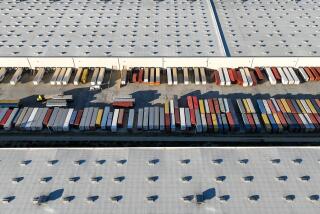In the Inland Empire, an industrial real estate boom
Nestled on the windy plains at the foot of the San Bernardino Mountains, once austere stretches of agricultural land have morphed into the country’s most desirable industrial real estate market, and it is growing faster than any other industrial region in the U.S.
Among the many merchants running large-scale operations now are such household names as Amazon.com Inc., Kohl’s Corp., Skechers USA Inc., Mattel Inc. and Stater Bros. Markets.
They come for vast warehouses — some are bigger than 30 football fields under one roof — where they can store, process and ship merchandise such as clothes, books and toys to ever more online shoppers and handle the rising flood of goods passing through the ports of Los Angeles and Long Beach.
The clamor for these big buildings is so intense in San Bernardino and Riverside counties that developers are erecting more than 16 million square feet of warehouses on speculation, meaning they are gambling that buyers or renters will rush forward to claim the buildings by the time they are complete.
“The Inland Empire is to industrial real estate what downtown Manhattan is to office real estate,” said Craig Meyer, head of industrial property brokerage in the U.S for Chicago firm Jones Lang LaSalle. “L.A. has been the hottest market in the world for 10 years running.”
Although the Inland Empire was hard hit by the recession and earned a reputation for mortgage foreclosures, evictions and high unemployment rates during the downturn, the industrial property business has remained a bright spot. And it is now picking up speed.
Southern California, with its enormous population and teeming seaports, has long been a vital hub for major retailers and manufacturers, real estate brokers said. But with Los Angeles and Orange counties essentially full, the Inland Empire with its wide-open spaces is now where the big new buildings are flying up.
Los Angeles County’s industrial vacancy is a mere 2.5%, the lowest in the country, said Kurt Strasmann of brokerage CBRE Group Inc., and some of the priciest industrial property in the U.S. is around Los Angeles International Airport. Orange County is the second-tightest market in the U.S., with 3.5% vacancy.
The two counties and the Inland Empire have a combined total of more than 1.65 billion square feet of industrial property, which is twice as big as the next largest market, Chicago.
“We are a big, deep market,” Strasmann said.
Key to all this is logistics — the organization and movement of goods to accommodate business. And it’s vital if the Inland Empire is to prosper, economist John Husing said. Blue-collar workers in logistics typically earn more than their counterparts employed in restaurants and other service jobs.
“It’s a very good match for our need to put primary wage earners in a family on the horizon to the middle class,” Husing said.
Setting up manufacturing and distribution operations in Southern California was mandatory for Fleischmann’s Vinegar Co., which traces its history to the 1920s, Chief Executive Ken Simril said.
The Cerritos company makes condiments, sauces and dressings for consumers and food flavorings and preservatives used by other food makers.
“For freshness, it’s important to be close to where people eat,” Simril said. Fleischmann’s also ships its products to Southeast Asia, and being close to the ports cuts transportation costs.
“It would have been cost-prohibitive to ship from the Midwest to the Pacific Rim,” he said.
Limited transportation costs have always been an attraction of the Los Angeles-area industrial property business. But recent changes in technology have created growing demand for warehouses so cavernous that they would have been too cumbersome to operate efficiently in the past, real estate broker Darla Longo of CBRE Group said.
Once upon a time, a warehouse was where you stored things for weeks or months, such as toys and canned food that retailers would grab to restock their shelves. Sorting, organizing and moving the inventory was a constant challenge.
Tracking goods in the modern age of bar codes, scanners and computers is a comparative breeze. The location of every widget can be identified with pinpoint accuracy and fetched by robots that can lift and carry 3,000-pound loads with ease.
“Technology has allowed larger facilities with more sophisticated equipment to be able to deliver products very efficiently,” Longo said, enabling businesses to consolidate their logistical operations into bigger warehouses. “And they don’t have to hire as many people because robotics can do work for them.”
Another driving force is the revolution in retail wrought by the Internet. Even retailers such as Wal-Mart Stores Inc. and Kohl’s, which have had successful bricks-and-mortar operations for decades, need additional warehouses for the “pick-and-pack” operations of their growing online sales divisions. The closer those operations can be to population centers, the less it costs the retailers and the more competitive they can be in courting cost-conscious customers.
“People look for products with free shipping,” Longo said. “We all want free shipping and we want to get it tomorrow. That’s an absolute shift.”
If the hurry-up-and-bring-it model of shopping continues on its current path, aggressive retailers will start to promise same-day delivery on orders placed by a certain time in the morning. Among those already testing same-day service are merchants offering a diverse array of products: Amazon, Wal-Mart, Sport Chalet Inc. and Nordstrom Inc.
Should the practice become widespread, retailers will probably need even more warehouses — including some in the heart of busy urban centers like such as Los Angeles — to keep truck travel time and fuel costs to a minimum.
“Gas is expensive,” Longo said.
So is real estate, of course. Urban warehouses would have to be compact and probably taller than their country cousins, brokers said.
Meanwhile, gargantuan warehouses continue to spring up at industrial parks in strategic locations in the Inland Empire.
Consider a 480,000-square-foot facility recently built for Quaker Oats Co. on land that used to be part of Norton Air Force Base in San Bernardino. It is so long at 1,000 feet that contractors laying the concrete floor used lasers to gently follow the curve of the Earth and keep the floor level.
The warehouse has 32-foot ceilings and enough doors to load or unload 124 trucks at the same time at what is now a regional distribution center for Quaker.
The sprawling former military base is being developed by Hillwood Investment Properties, a company owned by the well-known Perot family of Texas. Patriarch Ross Perot ran for president in 1992. Ross Perot Jr. is chairman of Hillwood, which started developing the property around what is now San Bernardino International Airport in 2002. The industrial park is called Alliance California.
Quaker has joined Amazon and a large tenant yet to be publicly identified on what was once the base’s golf course and clubhouse, said John Magness, a former Army helicopter pilot in charge of developing the airport property for Hillwood.
Over on the base’s old parade ground, Pep Boys’ western distribution center, like many others in the region, runs 24 hours a day.
The old base and nearby parcels owned by Hillwood have 11 million square feet of warehouse space but the property is only about 80% built out, Magness said. Among the projects on his to-do list is demolishing obsolete warehouses from the old base and building new ones.
Even though the aging wooden warehouses were big enough to store transport-airplane parts and were once considered grand, they look almost miniature compared with the new warehouses. The old structures are also plagued with asbestos tiles, lead paint and a lack of modern fire sprinklers, Magness said.
“Those buildings were built in the World War II era when 80,000 square feet was a big warehouse,” he said. The redwood structures also weren’t intended to facilitate quick loading and unloading of goods.
“Today’s buildings are built for speed because products rarely stay on the shelves for more than a week or so,” Magness said.
The vast majority of new industrial structures in the region will be used for shipping and receiving — not manufacturing. California has higher income taxes than nearby states such as Arizona, Nevada and Washington, which reduced the number of companies willing to set up manufacturing operations here, real estate experts said.
That may be starting to change as the cost of making goods overseas and shipping them to the U.S. rises, but so far the return of manufacturing is “mostly anecdotal,” said Meyer of Jones Lang LaSalle.
The rush is on among big retailers to create new networks of fulfillment centers that gather, process and ship goods ordered online. And experts say that promises even more industrial development in key locations near interstate highways and urban centers.
“Fulfillment,” Meyer said, “is the new manufacturing.”
More to Read
Inside the business of entertainment
The Wide Shot brings you news, analysis and insights on everything from streaming wars to production — and what it all means for the future.
You may occasionally receive promotional content from the Los Angeles Times.











